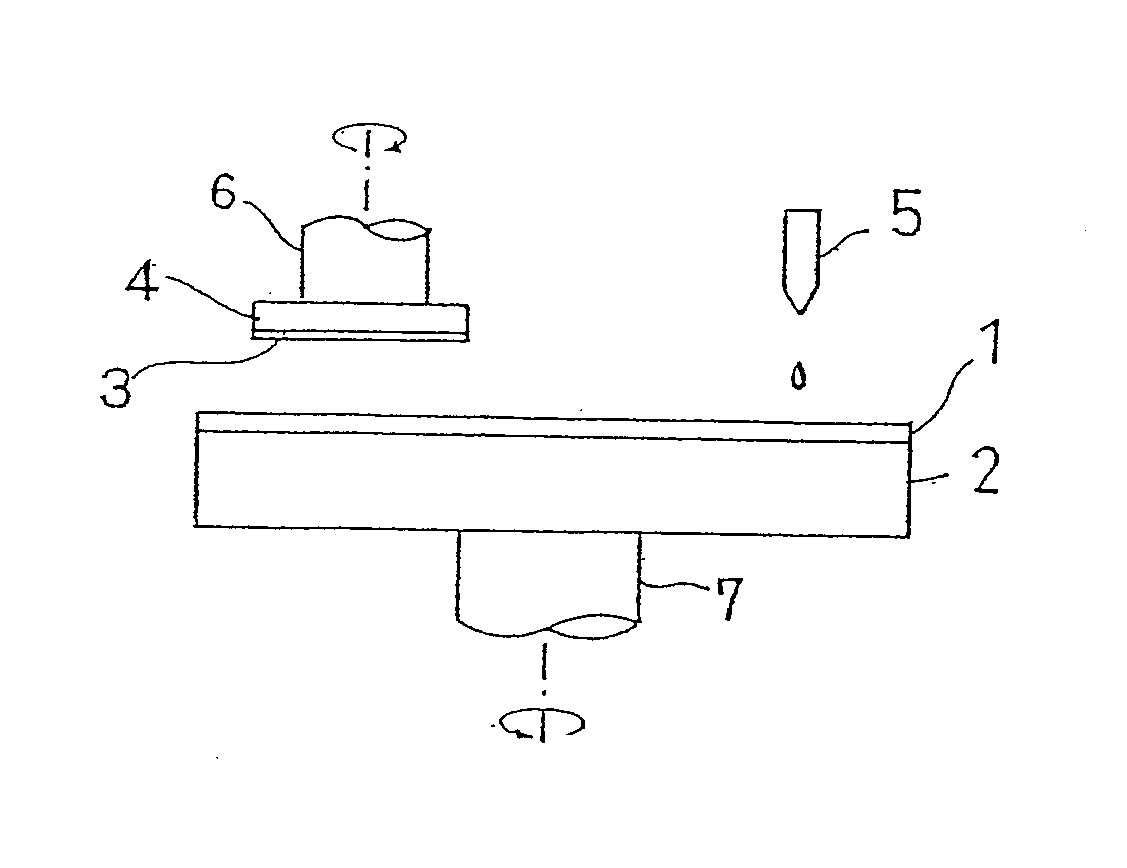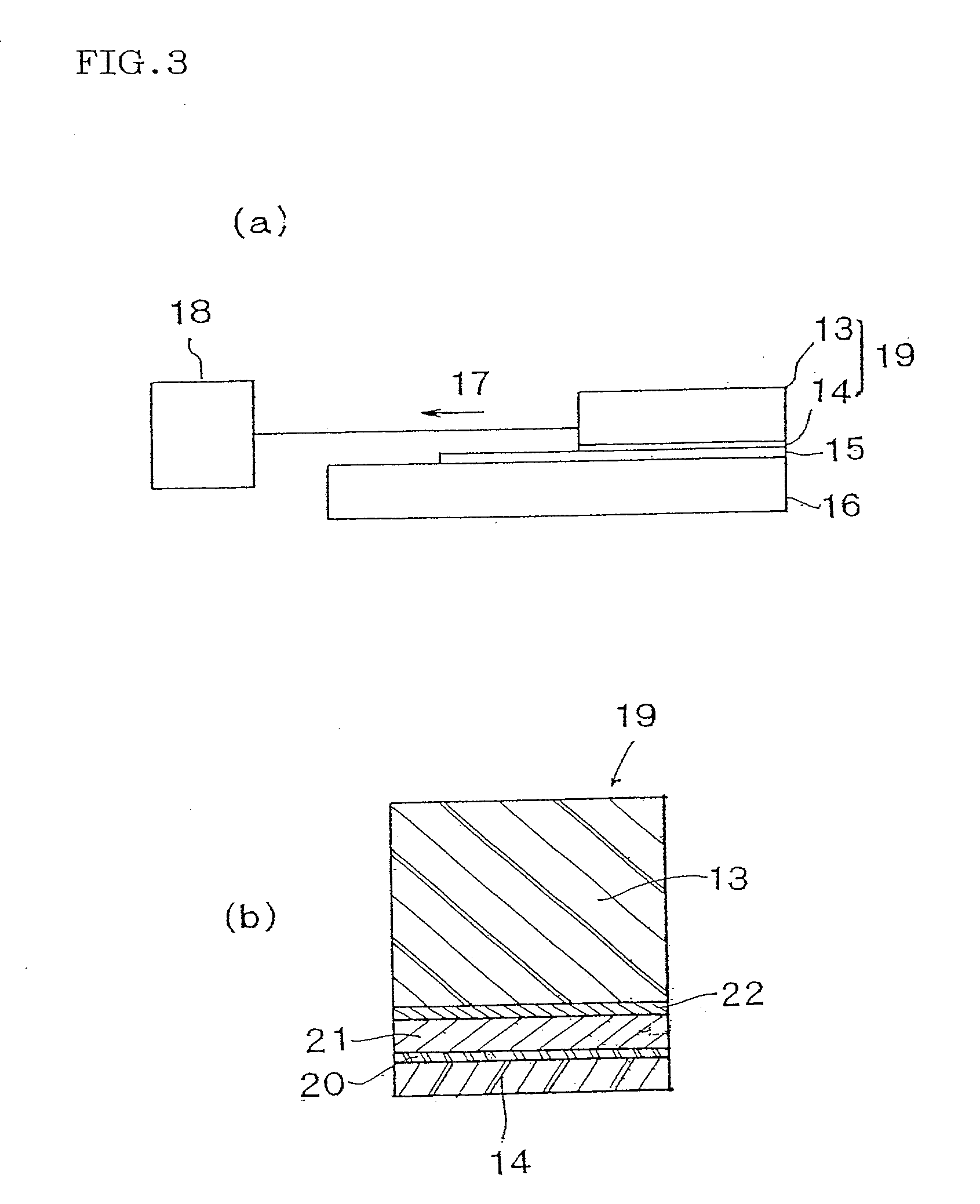Polishing pad and method of producing the same
a technology of polishing pad and plate, which is applied in the direction of lapping tools, metal-working apparatus, polyurea/polyurethane coating, etc., can solve the problems of poor planarizing characteristics in minute regions, unpractical prior art pads, and poor polishing rate, so as to achieve less resistance, not causing wafer breakage, and high polishing rate
- Summary
- Abstract
- Description
- Claims
- Application Information
AI Technical Summary
Benefits of technology
Problems solved by technology
Method used
Image
Examples
examples 1 to 3
[0237]
[0238] (Evaluation of Polishing Characteristics)
[0239] As the polishing apparatus, SPP600S manufactured by Okamoto Machine Tool Works, Ltd. was used in evaluation of polishing characteristics. The thickness of an oxide film was measured by an interference film thickness measuring device manufactured by Otsuka Denshisha. The polishing conditions were as follows: slurry SemiSperse-12 (manufactured by Cabot) was dropped at a flow rate of 150 ml / min., the polishing loading was 350 g / cm2, the number of revolutions of the polishing platen was 35 rpm, and the number of revolutions of the wafer was 30 rpm.
[0240] For evaluation of polishing characteristics, a 0.5 μm thermal-oxide film was deposited on an 8-inch silicone wafer and subjected to the following patterning (270 / 30 and 30 / 270 line / space), and then a 1 μm oxide film of p-TEOS was deposited thereon, to prepare a wafer having a pattern with an initial difference in level of 0.5 μm. This wafer was polished under the above-descr...
example 1
Example 1-1
[0256] 3000 parts by weight of a polyether-based urethane prepolymer (Adiprene L-325 manufactured by Uniroyal) and 120 parts by weight of a silicone-based surfactant SH192 (dimethyl polysiloxane / polyoxyalkylene glycol copolymer manufactured by Toray Dow Corning Silicone Co., Ltd.) were introduced into a vessel and mixed at about 900 rpm with a stirrer to produce a foamed solution (cell dispersion), and thereafter, the stirrer was exchanged with another stirrer, and 770 parts by weight of molten 4,4′-methylene-bis(2-chloroaniline) were introduced as a curing agent into it under stirring. The mixture was stirred for about 1 minute, and the mixed solution was introduced into a pan-type open mold and post-cured for 6 hours in an oven at 110° C., to produce a foamed polyurethane block. The resulting foamed polyurethane had 350 cells / mm2, an Asker D hardness of 52, a compressibility of 2.0%, a storage elastic modulus of 279 MPa, a specific gravity of 0.8 and an average cell di...
example 1-2
[0259] A polishing pad was prepared in the same manner as in Example 1 except that the amount of the silicone-based surfactant SH-192 in Example 1-1 was changed to 50 parts by weight. The resulting foamed polyurethane had 230 cells / mm2, a D hardness of 58, a compressibility of 1.4%, a storage elastic modulus of 295 MPa, a specific gravity of 0.87 and an average cell diameter of 35 μm. By elementary analysis with fluorescent X rays, Si was detected, and it was thus confirmed that the predetermined surfactant was contained.
PUM
 Login to View More
Login to View More Abstract
Description
Claims
Application Information
 Login to View More
Login to View More - R&D
- Intellectual Property
- Life Sciences
- Materials
- Tech Scout
- Unparalleled Data Quality
- Higher Quality Content
- 60% Fewer Hallucinations
Browse by: Latest US Patents, China's latest patents, Technical Efficacy Thesaurus, Application Domain, Technology Topic, Popular Technical Reports.
© 2025 PatSnap. All rights reserved.Legal|Privacy policy|Modern Slavery Act Transparency Statement|Sitemap|About US| Contact US: help@patsnap.com



